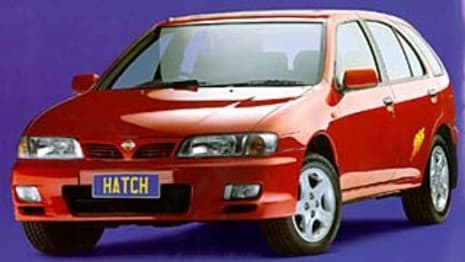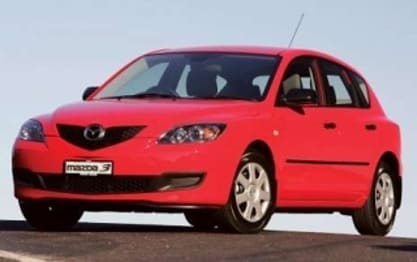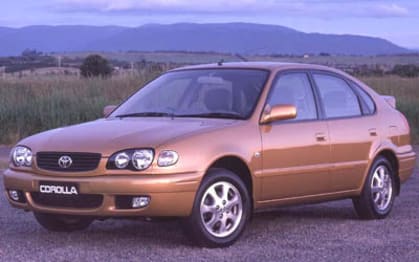
Used Nissan Pulsar review: 2000-2006
- Nissan Pulsar
- Nissan Pulsar 2006
- Nissan Pulsar 2005
- Nissan Pulsar 2004
- Nissan Pulsar 2003
- Nissan Pulsar 2000
- Nissan Pulsar 2001
- Nissan Pulsar 2002
- Nissan Pulsar Reviews
- Nissan Reviews
- Nissan Hatchback Range
- Nissan Sedan Range
- Hatchback
- Sedan
- Nissan
- Used Car Reviews

What we like
- Reliable
- Spacious
- Full-sized spare
What we don't
- Affected by Takata airbag recall
- Limited safety features
What we like
- Reliable
- Spacious
- Full-sized spare
What we don't
- Affected by Takata airbag recall
- Limited safety features
While Nissan stuck with what had been a very successful nameplate in Australia and continued to use the Pulsar badge for its new N16 model, it was renamed the Bluebird Sylphy in its homeland.
Following the end of local production, the Australian Pulsar was, by 2000, a fully imported model, with sedans sourced from Japan and hatches coming from the UK.
The N16 Pulsar was still a small, front-wheel-drive car, but with greater demand for small vehicles from a market rapidly downsizing, the little Nissan grew a little in size and sophistication to better meet this need head on.
Compared to the N15 that went before it, the new-generation Pulsar was longer, wider, taller, and better equipped.
Models
The N16 Pulsar was launched in sedan form in 2000, and the hatch followed in 2001.
Opening the five-model range was the LX, which was only offered as a four-door sedan with a 1.6-litre four-cylinder engine and the option of a four-speed automatic transmission or five-speed manual gearbox.
Standard features consisted of air-conditioning, an adjustable steering wheel, remote central locking, power mirrors, power steering, an immobiliser, cloth trim, and a radio/CD player with four speakers.
Safety features were limited to seat belt pretensioners and an airbag for the driver.
The ST was available as a sedan or hatch; it had a 1.8-litre four-cylinder engine and either a four-speed automatic transmission or five-speed manual gearbox.

It was similarly equipped to the LX, but had the extra protection of an airbag for the front seat passenger.
The Q was a popular model with its strong value-for-money proposition. It was available as a sedan or hatch, it had a 1.8-litre four-cylinder engine, and the choice of a four-speed automatic transmission or a five-speed manual gearbox.
Standard features that made the Q so popular included alloy wheels, power windows, and a rear spoiler.
Safety features in the Japan-sourced Q sedan were a driver's airbag and seat belt pretensioners, while the UK-sourced hatch also had an airbag for the front seat passenger.
The ST was likewise available as a sedan or hatch; it too had a 1.8-litre engine, and the choice of automatic transmission or manual gearbox.
ST standard features included air-conditioning, an adjustable steering wheel, remote central locking, power mirrors, power steering, and a radio/CD player with four speakers.
Like the Q, the ST sedan had a driver's airbag and seat belt pretensioners, while the hatch boasted airbags for both the driver and the front seat passenger.
The Ti was at the top of the range, and befittingly had the most when it came to standard features.
Available only as a sedan, with a 1.8-litre four-cylinder engine, and the choice of automatic transmission or manual gearbox, the Ti boasted climate-control air-conditioning, alloy wheels, remote central locking, immobiliser, power windows and mirrors, power steering, and a radio/CD player with four speakers.
It was also the best equipped when it came to safety features; they included airbags for the driver and front seat passenger, seat belt pretensioners, and ABS anti-lock braking.
An update in 2003 saw the release of the Series II which introduced a raft of changes across the range.
The LX and Ti disappeared from the range, so all models then had 1.8-litre engines, which were revised, and the ST-L was introduced.
Only offered in sedan form, the ST-L came with the 1.8-litre engine, and an automatic transmission or manual gearbox.
Standard features of the ST-L were air-conditioning, alloy wheels, remote central locking, power windows and mirrors, power steering, and a radio/CD player with four speakers.
In other revisions, the ST got standard cruise control, while the Q got ABS braking with electronic brakeforce distribution, larger alloy wheels, and a sporty leather-wrapped steering wheel.
Predating Bluetooth, it wasn't possible to connect an iPhone or an Android device, there was no touch screen, sat nav, or parking aids such as a reversing camera, parking sensors, or a park assist system.
The spare tyre was full-sized.
Cabin
With its larger dimensions, the N16 offered greater comfort and head and legroom to those in the front or rear seats.
The cabin was well laid-out, the materials used had a quality feel and appearance, and the seats were comfortable.
The rear seat was a split/fold one to add to the flexibility of the cabin, with plenty of luggage space available when the seat was folded.
Cupholders were provided for those in the front.
Lap/sash seat belts facilitated the fitment of a baby car seat, but the N16 predated the requirement of ISOFIX mounting points.
Engine
At the launch of the N16, the entry-level LX model had a 1.6-litre four-cylinder petrol engine, the rest of the range had 1.8-litre four-cylinder engines with 16 valves.
That changed in 2003 when the LX was dropped from the Series II range. Thereafter, all models boasted the smooth, flexible performance of the 1.8-litre engine.
The 1.6-litre engine was capable of putting out 83kW – 111 horsepower – at its power peak, and 140Nm when at its point of maximum torque.
While the 1.6-ltre engine was a smooth, capable little engine, the 1.8-litre engine was the star of the show. At its performance peaks it put 92kW – 123 horsepower – and 161Nm, which endowed it with greater zip, but more importantly better flexibility for smoother driveability.
Post 2003, the 1.8-litre engine had slightly reduced peak power of 90kW, but a little more maximum torque of 163Nm. Both engines ran on 91-octane regular unleaded petrol. They were offered with the choice of a five-speed manual gearbox or four-speed automatic transmission - the latter the most popular.
Driving
With MacPherson strut independent front suspension and a multi-link beam rear suspension, the N16 Pulsar handled, steered, and stopped with assurance.
It wasn't sports car precise, but it did what it was intended to do and didn't cause anyone a moment's distress.
The 1.6-litre engine used in the LX in the Series I range was nice enough, but it lacked the performance modern day traffic demands. In contrast, the 1.8-litre engine was sufficiently powerful to get the job done in the bustle of town life.
There was sufficient torque to deliver the flexibility and smooth driveability that makes the day-to-day driving experience a pleasant one, even with the limitations of a four-speed automatic transmission.
For those in the cabin, the ride was comfortable, and there was little wind or road noise to cause any concern.
Safety
Comprehensive standard safety equipment was bit of a work in progress when the N16 was launched. When released, safety features consisted of an airbag for the driver and seat belt pretensioners - it wasn't until the Series II update in 2003 that a front passenger's airbag became standard.
It was a similar tale of woe when it came to the very important ABS anti-lock braking, which only became standard in the Series II update.
ANCAP rated the Series II at three (out of five) stars for safety.

Any common issues?
Owners and mechanics agree the reliability of the N16 Pulsar is exemplary.
There is nothing to be concerned about with the N16, even if it's done high mileage, providing it has been well cared for and is in good condition.
Nothing beats regular servicing to keep a car in tip-top shape, so it's critical that the seller provides a service record to show their car has been properly maintained.
Older cars are often neglected by owners not wanting to spend money on a car they see as of little value. If there's no service record, and the car appears neglected, walk away.
Look for signs of wear and tear, such as oil smoke from the exhaust, oil leaks around the engine and transmission, and coolant leaks.
The engines have cam timing chains, so there's no requirement for servicing them.
Being a conventional automatic transmission, there are none of the issues that have plagued new-tech transmissions like dual-clutch and CVT gearboxes. But it's important as the kilometres climb to check the auto is working smoothly and engaging gears without flaring or hesitation.
Nissan covered the N16 Pulsar with a three-year/100,000km warranty when new, and recommended it be serviced every 10,000km or six months.
The recommended oil is 5W-30.
Capped-price servicing was yet to be introduced, but there's nothing in the N16 Pulsar to make the service costs expensive.
The N16 Pulsar is affected by the Takata airbag inflator recall, so check with the seller to see if their car has been recalled. If it hasn't, check with the dealer to see when it will be.
If anything crops up, you'll probably find it on our Nissan Pulsar problems page.
Owners view
Belinda Rogers: "I've had my 2004 Pulsar for 14 years and it's still going strong. It's been a real little beauty, and has never let me down."
Allan Savage: "We bought our Ti used in 2010. It's now done 420,000 km and has not caused us a moment's trouble."
Ellen Chadwick: "I've had my ST for three years now and have found it very practical. There's plenty of room in the back, the doors open wide enough to make it easy for older people to get in and out, and it's cheap to run."
Jack Billings: "I've had my ST for two years, and in that time it's cost me nothing apart from regular running expenses. It's a great car for someone wanting cheap transport."
Marion Baldwin: "I love my ST, which I bought used in 2013. It's roomy, economical, and is nice to drive."
Rivals
Toyota Corolla
Sound and reliable, if in tip-top shape.
3 stars
Mazda3
A class act and drives nicely, but it can be thirsty.
3 stars.
Ford Focus
A great handler let down by bland interior and lacklustre engine.
2.5 stars.
Verdict
Reliable small car, a sensible cheap used buy.
Rating: 3.5 stars.
Pricing
| Year | Price From | Price To |
|---|---|---|
| 2006 | $2,640 | $4,400 |
| 2005 | $2,420 | $4,070 |
| 2004 | $2,310 | $4,070 |
| 2003 | $2,310 | $4,290 |
| 2002 | $2,310 | $4,290 |
| 2001 | $2,310 | $4,290 |
| 2000 | $1,980 | $5,280 |
Pricing guides
Range and Specs
| Vehicle | Specs | Price* | |
|---|---|---|---|
| LX | 1.6L, ULP, 4 SP AUTO | $2,090 – 3,300 | 2000 Nissan Pulsar 2000 LX Pricing and Specs |
| LX | 1.6L, ULP, 5 SP MAN | $1,980 – 3,080 | 2000 Nissan Pulsar 2000 LX Pricing and Specs |
| Plus | 1.6L, ULP, 5 SP MAN | $2,090 – 3,300 | 2000 Nissan Pulsar 2000 Plus Pricing and Specs |
| Plus | 1.6L, ULP, 4 SP AUTO | $2,640 – 4,070 | 2000 Nissan Pulsar 2000 Plus Pricing and Specs |
Other cars to consider
$1,999
Lowest price, based on 6 car listings in the last 6 months













